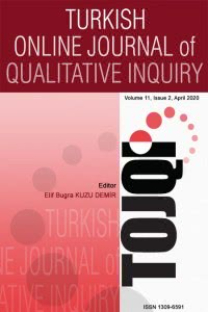Determination of the Relative Positions of Three Planes: Action Research
Bu çalışmanın amacı, ilköğretim Matematik öğretmen adaylarının uzayda düzlemlerin analitik incelenmesi konusundaki başarısını arttırmak için daha etkili bir ders planının ve öğretim ortamının nasıl sağlanacağını araştırmaktır. Bu amaca ulaşabilmek için araştırmacıların hazırladığı plan dahilinde eylem araştırması yaklaşımı kullanılmıştır. Uygulamanın 1. aşamasında öğretmen adaylarına üç düzlemin denklemleri verilerek düzlemlerin birbirine göre konumlarının belirlenmesi istenmiştir. Bu aşamada öğretmen adayları düzlemlerin birbirine göre konumunu ikişer ikişer düzlem denklemlerini inceleyerek tek yönlü belirlemeye çalışmıştır. Uygulamanın ikinci aşamasında üç bilinmeyenli üç denklemden oluşan lineer denklem sistemlerinin çözümünü bulmaları ve bu çözümü geometrik olarak yorumlamaları istenmiştir. Bu aşamada ise öğretmen adaylarının bir kısmı denklem sistemini çözdüğü ancak geometrik olarak yorumlayamadığı gözlemlenmiştir. Üçüncü aşamada ise üç düzlemin birbirine göre konumunun görselleştirmesi ve düzlem denklemlerini kullanarak bu düzlemlerin birbirlerine göre konumlarını gözlemleyebilmeleri için bilgisayar cebir sistemlerinden Maple programı kullanılmıştır. Bu aşamada öğretmen adayları düzlem denklemlerinin oluşturduğu denklem sistemlerinin çözüm kümesi ile Maple da elde edilen üç boyutlu görselleri ilişkilendirmişlerdir. Uygulamadan elde edilen bulgulara göre hazırlanan planın matematik öğretmen adaylarının üç düzlemin birbirine göre konumunun görselleştirmesinde olumlu etkisi olmuştur.
Üç Düzlemin Birbirine Göre Konumunun Belirlenmesi: Eylem Araştırması
The purpose of this study was to explore how a more effective lesson plan and teaching environment can be achieved so as to improve elementary mathematics teacher candidates' achievement in analytical examination of planes in space. In order to improve achievement in expressing the relative positions of three planes not only algebraically but also visually the study used an action research approach as planned by the researchers. In Implementation 1, the teacher candidates were given the equations of three planes and they were asked to determine the relative positions of the planes so that their prior knowledge could be identified. In this stage, the candidate teachers tried to determine the relative positions of the planes in one direction by examining the plane equations in pairs. In Implementation 2, the candidate teachers were asked to find the solution set of the linear equation system consisting of three equations with three unknowns and to come up with geometric interpretation of this solution. In this stage, some of the candidate teachers were able to solve the equation, but they couldn't interpret it geometrically. In Implementation 3, Maple, a computer algebra system, was used so that the candidate teachers could visualize and observe the relative positions of the three planes by using the plane equations. In this stage, the candidate teachers associated the set of solutions of the plane equations with the three-dimensional images obtained with Maple. The results of the implementation showed that the proposed plan improved the mathematics teacher candidates' visualization of the relative positions of the three planes.
___
- Baki, A., Kösa, T., & Karakuş, F. (2008). Uzay geometri öğretiminde 3D dinamik geometri yazılımı kullanımı: Öğretmen Görüşleri. Paper presented at 8th International Education Technology Conference, Anadolu University, Eskişehir, Turkey.
- Baki, A., Erkan, İ., Demir, E.(2012). Ders planı etkililiğinin lesson study ile geliştirilmesi: bir aksiyon araştırması. Paper presented at X. Ulusal Fen Bilimleri ve Matematik Eğitimi Kongresi [X. Congress on International Science and Mathematics Education], Niğde University, Niğde, Turkey.
- Bako, M. (2003). Different projecting methods in teaching spatial geometry. Retrieved from http://www.dm.unipi.it/~didattica/CERME3/proceedings/Groups/TG7/TG7_Bako_cer me3.pdf
- Çepni S. (2010). Araştırma ve proje çalışmalarına giriş. Trabzon: KTÜ Fatih Eğitim Fakültesi Yayınları.
- Kösa, T., Karakuş, F., & Çakıroğlu, Ü. (2008). Uzay geometri öğretimi için üç boyutlu dinamik geometri yazılımı kullanarak çalışma yapraklarının geliştirilmesi, Paper presented al International Educational Technology Conference. Anadolu University, Eskişehir, Turkey.
- Schumann, H. (2003). Computer aided treatment of 3d- problems in analytic geometry. Zentralblatt für Didaktik der Mathematik (ZDM), 35 (1), 7-13.
